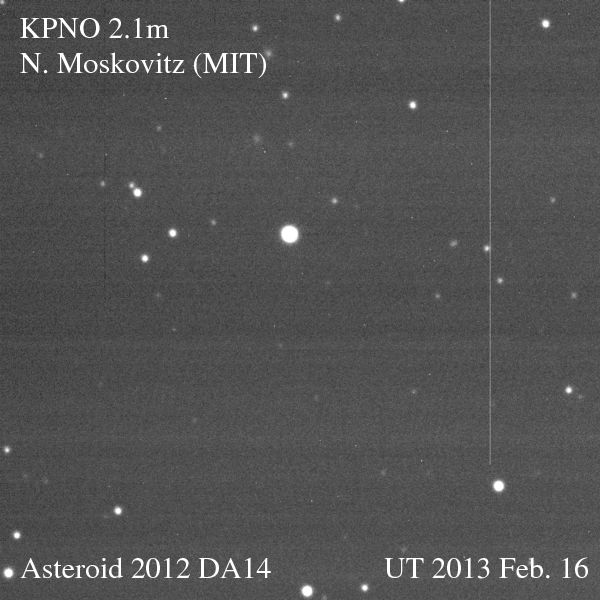Low-resolution imagery from NASA's Goldstone radar dish shows asteroid 2012 DA14 flying away on Feb. 15-16.
By Alan Boyle, Science Editor, NBC News
A pixelated profile from NASA's Goldstone radar dish makes the passing asteroid 2012 DA14 look a bit like an out-of-control Viper space fighter from "Battlestar Galactica." But the real-life asteroid is almost five times as big, and might well pack a bigger wallop if it ever hit our planet.
NASA's Jet Propulsion Laboratory on Tuesday released a movie combining 73 radar images of 2012 DA14, captured over the course of eight hours on the night of Feb. 15-16. The image resolution is 13 feet (4 meters) per pixel.
In a news release, NASA said the images show the roughly 130-foot-long (40-meter-long) asteroid moving away from us, at a distance ranging from 74,000 miles to 195,000 miles (120,000 to 314,000 kilometers). These readings were made just hours after the time of closest approach, when the asteroid came within 17,200 miles (27,680 kilometers) of our planet.
2012 DA14's close encounter on Feb. 15 was eclipsed by the nuclear-scale impact of a meteor over the Russian city of Chelyabinsk earlier in the day ? a widely witnessed event that caused more than 1,200 injuries and did an estimated $33 million in damage. NASA said the asteroid behind Russia's meteoric display was about a third the size of 2012 DA14.
If 2012 DA14 had hit instead, the damage would have been much, much worse. Experts have compared the bigger space rock to the object that blew up over a Siberian forest in 1908, knocking down millions of trees over an 820-square-mile area. As it is, the Russian meteor rates as the biggest observed cosmic impact since Siberia's Tunguska event.
JPL's radar observations, which continue through Wednesday, are aimed at fine-tuning the calculations of 2012 DA14's future orbit by getting a better fix on its size, shape, rotation, surface features and surface roughness. For what it's worth, the asteroid's estimated length of 40 meters along its long axis is between four and five times the length of the Colonial Viper spacecraft that buzzed the Cylons in the "Battlestar Galactica" TV series.
The asteroid's path was perturbed by Earth's gravitational field in such a way that it won't come as close in the foreseeable future. However,?a better understanding of its orbit and its composition could help scientists prepare for encounters with other asteroids ? and?figure out the best way to divert potentially threatening near-Earth objects.
The radar observation campaign is led by JPL's Lance Benner and Marina Brozovic.
Here are a more views of 2012 DA14 from other observers:

An international team led by MIT's Nicholas Moskovitz observed asteroid 2012 DA14 with a number of telescopes, including the 2.1-meter telescope at Kitt Peak National Observatory. This animated image shows the asteroid as it was leaving Earth's vicinity. Check out the National Optical Astronomy Observatory's news release for more information. If you missed seeing the animation, click here for a refreshed view.
More about the asteroid:
Alan Boyle is NBCNews.com's science editor. Connect with the Cosmic Log community by "liking" the log's?Facebook page, following?@b0yle on Twitter?and adding the?Cosmic Log page?to your Google+ presence. To keep up with Cosmic Log as well as NBCNews.com's other stories about science and space, sign up for the Tech & Science newsletter, delivered to your email in-box every weekday. You can also check out?"The Case for Pluto,"?my book about the controversial dwarf planet and the search for new worlds.
This story was originally published on Tue Feb 19, 2013 5:24 PM EST
brandon inge freedom tower freedom tower eric church world trade center quick silver where have you been rihanna
কোন মন্তব্য নেই:
একটি মন্তব্য পোস্ট করুন